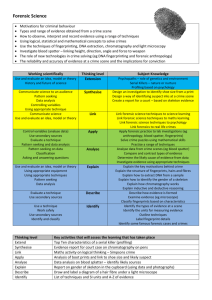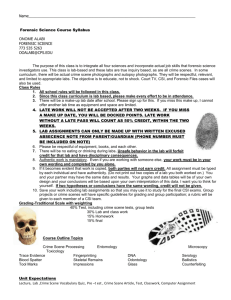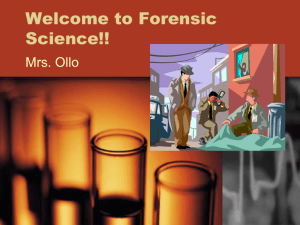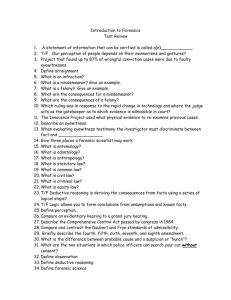File
advertisement
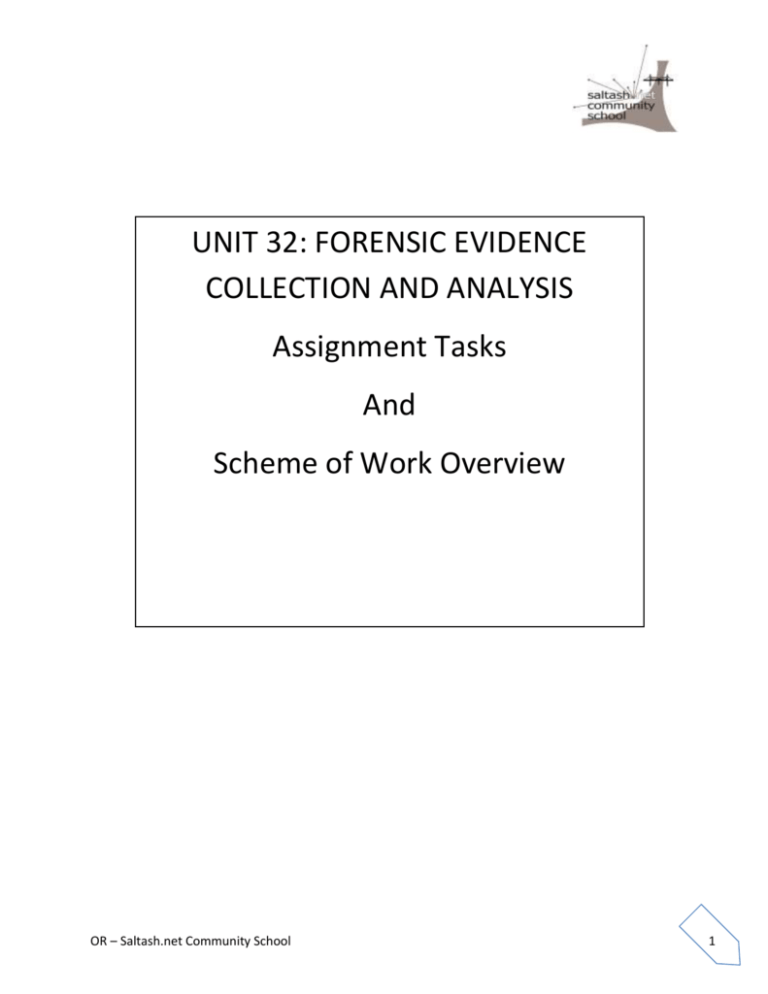
UNIT 32: FORENSIC EVIDENCE COLLECTION AND ANALYSIS Assignment Tasks And Scheme of Work Overview OR – Saltash.net Community School 1 Learning Outcomes On completion of this unit, a learner should: 1 Be able to gather ‘forensic’ evidence from a simulated crime scene using appropriate methods and present the results 2 Understand the chemical techniques used in the analysis of evidence from a crime scene 3 Understand the physical techniques used in the analysis of evidence from a crime scene 4 Understand the biological techniques used in the analysis of evidence from a crime scene This what the students will learn during Unit 32, this contains information for P, M and D levels. 1 Be able to gather ‘forensic’ evidence from a simulated crime scene using appropriate methods and present the results Documentation: collecting; recording; storing and distributing data by electronic means Evidence: targeting and recovery of trace materials; characterisation and comparison; marks and impressions Health and safety: eg Health and Safety Act 1974; eg COSHH Regulations 1996; eg Management of Health and Safety at Work Regulations 1992; disposable protective clothing Preservation of scene and sampling: observation and recording of the scene; restriction of access; search for material of potential evidential value; packaging and labelling; storage and transmission to laboratory Analysis and evaluation: prevention of contamination; security; records; full documentation of procedures and methods 2 Understand the chemical techniques used in the analysis of evidence from a crime scene Spectrometry: instrumental techniques; mass spectrometry; infrared; ultraviolet; colorimetry Chromatography: separation of mixtures eg paper, column, thin layer (TLC), gasliquid (GLC), high performance liquid (HPLC) Toxicology: science of poisons; detection; effects; antidotes OR – Saltash.net Community School 2 3 Understand the physical techniques used in the analysis of evidence from a crime scene Audiometry: instrumental methods of recording sound information Photography: images of traffic; surveillance; public order offences; support team at major incidents; high quality record of exhibits eg taking devices apart Ballistics: interior and exterior ballistics; firearms; cartridges; calibre; discharge; residue Electronics: electronic imaging; enhancement techniques to improve photography and video; television monitors; cameras; alarms Metrology: study of weights and measures 4 Understand the biological techniques used in the analysis of evidence from a crime scene Analysis: paper; entomology; genetics (DNA sequencing, genetic fingerprints) Histology: study of tissues and tissue types; fingerprints (four basic patterns); blood group analysis Skeleton and anthropology: physiology of bone and skeleton Microscopy: measurement and comparative microscopy OR – Saltash.net Community School 3 Contents Page. Page 2 – 3. Page 4. Page 5 . Learning Outcomes and Unit Content Contents Page. How to use these assignments OR – Saltash.net Community School 4 How to use the assignments. In each assignment there are the same forms, below is guidance on how each form should be used. 1. Teachers Level Sheet (one for the whole unit) – this lists the requirements that each student needs to complete in order to pass that level, this is the gold standard of what a Pass, Merit and Distinction are. If students meet these even though they don’t complete all the tasks then they still pass. These are used as the objectives 2. Student Cover Sheet (one per assignment) – gives the student the information on the assignment and what the big picture is. The start date and target completion date need to be filled in before handing to students and this needs to be signed and dated by you when they complete the assignment. This needs to goon the front of each assignment. 3. Student tick list (one per assignment) – gives objectives (blue boxes) and lists the outcomes (in the tables) that the student needs to complete in order to meet each level. Care has been taken to ensure that if a student completes all the tasks then they will have met all the objectives. This also needs to be signed by you and the student for each level and submitted with the work. There is space at the bottom to show what the student needs to do to either complete the level or move onto the next one. 4. Lesson guidance (one per assignment) – lists the activities that should be completed in each lesson. This is guidance only. All students will have a paper copy of the big picture, objectives and the outcomes from the two sheets above but you may still want to display these to the whole class. 5. Resources (one per assignment) – any resources needed to complete the tasks, will be referred to in the lesson guidance. OR – Saltash.net Community School 5 Teachers Level Sheet – Unit 32 Forensic Science OR – Saltash.net Community School 6 Student Cover Sheet. Forensic Science– Assignment 1 Student Name Level Course Title Unit Title Assignment Number Topic or Theme Big Picture Group BTEC National Award and Certificate Applied Science Unit32: Forensic Science 1 (P1,M2, D,1,) A forensic investigation requires several different professionals who each play a role in the case. During this assignment you will look at the roles of Scene of Crime offers and Forensic scientists Scenario You have just been accepted as a trainee forensic scientist. Your first task in this position is to prove what you have learnt so far in training but also on the job. You must produce a portfolio of your work so far that highlights how to collect and analyse data. If you can prove yourself then your employee is willing to allow you to attend the scene of a crime and assist in the collection and analysis of evidence. For this you will be required to write a report of how you collected and analysed the evidence. You will then need to draw and justify your conclusions in the report which will later be submitted to court. Task one – collect evidence from crime scene as a SOCO Task two – Analyse evidence from a crime scene as a Forensic Scientist Task three- Write a report of your finding to be submitted to court Good luck on your first case Date issued Date Submitted Signed by Teacher Signed by Student OR – Saltash.net Community School 7 Task one – Gathering evidence from a crime scene student tick sheet Arrive at crime scene and carryout the following steps P1 carry out a forensic examination of a simulated crime scene, using appropriate methods to gather biological, physical and chemical evidence Secure crime scene using appropriate equipment Sketch and photograph the crime scene Correctly mark and photograph evidence found at crime scene using either quadrant, link, strip/line, grid, spiral or wheel method Collect evidence found at the crime scene using the appropriate equipment Collect the teacher observation form Produce a report of how you collected the evidence using your photos. You should write a brief description of what you are doing in each picture Your report produced for P1 must describe fully each procedure and piece of equipment you used to secure and collect evidence from the crime scene. This should include use of protective clothing and health and safety M1 describe the procedures used to gather evidence from a simulated crime scene Show clear diagrams in your portfolio of how forensic scientists gather evidence from a crime scene. This should include how evidence is documented, transported and stored. You must include the following; Note-taking, Sketching, photographs, targeting and recovery of evidence, packaging and labelling Summarise the following terms and describe the importance of each; Common approach path, Contamination, Cross contamination, Gel filter, Chain of continuity, Latent, First attending officer, restriction of access Complete worksheet 1 D1 justify the procedures used to gather evidence from a simulated crime scene In your report you must justify the procedures and equipment used in the collection and gathering of each evidence. This should include what would happen if you did not follow procedures in terms of safety and contamination. Explain three alternative methods/equipment that you could have used to better your investigation Discuss the term over looking evidence and how this risk can be reduced by using the right methods correctly OR – Saltash.net Community School 8 Task two – Analyse evidence from a crime scene as a Forensic Scientist P2 outline the main techniques used to analyse chemical evidence P4 outline the main techniques to analyse physical evidence P6 outline the main techniques used to analyse biological evidence Briefly describe the following chemical techniques and how they could be used to analyse evidence Spectrometry Colorimetry UV and IR spectroscopy Chromatography Chemical enhancement Chemical presumptive tests toxicology Briefly describe how the following physical techniques and how they could be used to analyse evidence Photography Ballistics (guns, microstamping, discharge residue, wound patterns, trajectory) Document examination (handwriting, signatures, printed documents) Briefly describe the following biological techniques could be used to analyse evidence P3 carry out practical work used to analyse chemical evidence gathered from a simulated crime scene P5 carry out practical work used to analyse physical evidence gathered from a simulated crime scene P7 carry out practical work to analyse biological evidence gathered from a simulated crime scene Blood group analysis DNA sequencing Fingerprints Hair and fibre Bones and skeleton physiology microscopy Followed methods for the different analytical techniques outlined above and have a completed teacher observation sheet for the experiments Follow your plans above to analyse the pieces of chemical, biological and physical evidence found at the crime scene Record your results accurately in a suitable format Teacher comments OR – Saltash.net Community School 9 Analysis of evidence Merit Criteria You must give a detailed explanation of all the major techniques that you described in P2,4,6 (the chemical, physical and biological techniques) You will also need to Give two examples of when forensic scientists may use the methods given Give an appropriate example of your forensic application to the simulated crime scene M2 explain the main techniques used to analyse chemical evidence M4 explain the main techniques to analyse physical evidence M6 explain the main techniques used to analyse biological evidence Using the information you have gained in P1 you must now plan how you will analyse each item of evidence from the crime scene. This will need to be represented as a method sheet M3 present valid conclusions drawn from the analysis of chemical evidence gathered from a simulated crime scene M5 present valid conclusions drawn from the analysis of physical evidence gathered from a simulated crime scene M7 present valid conclusions drawn from the analysis of biological evidence gathered from a simulated crime You must draw conclusions from each analysis that you have carried out. This needs to Link suspects to the evidence Eliminate suspects from the evidence Use the evidence and data in the conclusion Make sure that you support your conclusions with evidence and reasoning. You must do this for the Merit Teacher Comments for Improvement Analysis of evidence Distinction Criteria OR – Saltash.net Community School 10 Evaluate all of the techniques that you have used in your investigation and explain why the techniques used were suitable D2 evaluate the techniques used to analyse chemical evidence D4 evaluate the techniques used to analyse physical evidence D6 evaluate the techniques used to analyse biological evidence D3 D5 D7 justify the choice of techniques used to analyse the chemical, biological and physical evidence gathered Justify your choice of equipment and whether you would use the same apparatus/technique again and if so or not explain why. Discuss alternative techniques that you could also have used explaining how they could have assisted your case In your portfolio you will need to produce a table that discusses the advantages and disadvantages of each method that you have used. This will need to be off all methods outlined in P2,4,6. Explain how the techniques you have used could be applied to different types of criminal investigations Teacher Comments for Improvement OR – Saltash.net Community School 11 Task three- Write a report of your findings to be submitted to court Produce a case file of the investigation. This will need to include P8 report on a chemical, physical and biological forensic examination A description of your crime scene examination A description of analysis Results from your investigation Conclusions from your report You will need to submit everything from your crime scene and laboratory analysis documentation as part of your case file. Give evidence in the mock court room explaining your role in the criminal investigation You will need to give clear and logical justification for the conclusions that you have drawn from the evidence you have collected and analysed. In doing so you must M8 justify the conclusions drawn in the report. Support your conclusion with evidence and reasoning comment on the relevance of each piece of evidence to the case in your report consider whether evidence may be circumstantial and alternative motives behind the evidence Evaluate your investigation in terms of precision, techniques and accuracy D8 evaluate their findings, including aspects of probability. Discuss the strengths and weaknesses of your results and conclusions TeacherDiscuss Comments for Improvement your conclusions in terms of possible, probable, likely OR – Saltash.net Community School 12 Lessons and dates Learning Outcomes You should be able to: Introduction to unit 1 Activities Introduction to unit and learners booklet passed out. Deadlines given Practical – every contact leaves a trace Reliability of witness Homework Write an introduction for your portfolio. Who you are and what your portfolio will contain Hand in 17/09/10 2 3 +4 4, 5, 6,7 P1 carry out a forensic examination of a simulated crime scene using appropriate methods to gather biological, physical and chemical M1 Describe the procedures used to gather evidence from a simulated crime scene Practical – processing a crime scene and collecting evidence P1 carry out a forensic examination of a simulated crime scene using appropriate methods to gather biological, physical and chemical M1 Describe the procedures used to gather evidence from a simulated crime scene Practical – processing a crime scene and collecting evidence P1 carry out a forensic examination of a simulated crime scene using appropriate methods to gather biological, physical and chemical M1 Describe the procedures used to gather evidence from a simulated crime scene D1 Justify the procedures used to gather evidence from a simulated crime scene Lesson 4-5 Complete photography worksheet (M1, D1) Main points Note-taking Sketching Photographing Main points Searching for evidence Targeting and recovery Packaging and labelling Practical – independently process and collect evidence from a crime scene. Portfolio – complete your portfolio of how to process a crime scene You receive a call from your chief inspector regarding a crime that has occurred. You rush to the crime scene to find a young caucasian male with a single bullet wound to his head. You are in charge of discovering all evidence to find out whether it was murder or suicide Tool marks, blood, hair, fingerprints, fibre, saliva, bullet casing, gun powder, drugs Learner observation sheet to be completed OR – Saltash.net Community School 13 Lesson 6-7 Write up – How to process a crime scene for the portfolio using success criteria from student sheets 8 27/09/11 9 03/10/11 P2 Outline the main techniques used to analyse chemical evidence M2 Explain the main techniques used to analyse chemical evidence D2 Evaluate the techniques used to analyse chemical evidence Practical – Chromatography techniques in forensic science P2 Outline the main techniques used to analyse chemical evidence M2 Explain the main techniques used to analyse chemical evidence Practical – Colorimetry as a chemical analysis technique D2 Evaluate the techniques used to analyse chemical evidence 10 04/10/11 P2 Outline the main techniques used to analyse chemical evidence M2 Explain the main techniques used to analyse chemical evidence D2 Evaluate the techniques used to analyse chemical evidence Paper chromatography and TLC Procedure sheet needs to be completed as well as a brief description of how it works Procedure sheet needs to be completed as well as a brief description of how it works Fingerprint chemical enhancement Practical – Different methods of finding fingerprint Iodine Ninhydrin Crystal violet Procedure sheet needs to be completed as well as a brief description of how it works 11, 12 10/10/11 P2 Outline the main techniques used to analyse chemical evidence M2 Explain the main techniques used to analyse chemical evidence D2 Evaluate the techniques used to analyse chemical evidence Produce a document for your portfolio showing the four different types of fingerprints. You must show on the document how forensic scientists match prints Hand in 13/10/10 Practical – chemical presumptive tests of body fluids Blood analysis Saliva testing Urine testing Write up – use of presumptive tests in forensic science 13 11/10/11 P2 Outline the main techniques used to analyse chemical evidence M2 Explain the main techniques OR – Saltash.net Community School Research and describe how forensic scientists use the following procedures Ensure portfolio of chemical evidence is complete 14 14,15 17/10/11 18/10/11 16, 17 31/10/11 used to analyse chemical evidence D2 Evaluate the techniques used to analyse chemical evidence Spectrometry P4 Outline the main techniques used to analyse physical evidence M4 Explain the main techniques used to analyse physical evidence D4 Evaluate the techniques used to analyse chemical evidence Introduction to Ballistics UV spectroscopy Infrared spectroscopy Mass Spectrometry Hand in 15/10/10 Practical – observation of bullet casings Research and explain how forensic scientists use the following Microstamping Discharge residue Wound patterns trajectory P6 Outline the main techniques used to analyse biological evidence M6 Explain the main techniques used to analyse biological evidence D6 Evaluate the techniques used to analyse biological evidence P4 Outline the main techniques used to analyse physical evidence M4 Explain the main techniques used to analyse physical evidence D4 Evaluate the techniques used to analyse chemical evidence Practical – hair and fibre identification and analysis Produce a table to look at advantages and disadvantages of different methods of analysis in forensic science. It should include uses, pros, cons, alternatives. You should also have a minimum of 8 methods Hand in 12/11/10 18 01/11/11 19 7/11/11 P4 Outline the main techniques used to analyse physical evidence M4 Explain the main techniques used to analyse physical evidence D4 Evaluate the techniques used to analyse chemical evidence Document examination P6 Outline the main techniques used to analyse biological evidence M6 Explain the main techniques used to analyse biological evidence D6 Evaluate the techniques used to analyse biological evidence Practical - blood typing and DNA profiling OR – Saltash.net Community School Practical – Handwriting analysis Research what led to Harold Shipman conviction – hint old typewriter 15 20 14/11/11 21-28 14/11/11 – 05/12/11 P6 Outline the main techniques used to analyse biological evidence M6 Explain the main techniques used to analyse biological evidence D6 Evaluate the techniques used to analyse biological evidence Fingerprint patterns P3,5,7 Carry out practical work used to analyse evidence gathered from a simulated crime scene M3,5,7 Present valid conclusions drawn from the analysis of evidence gathered from a simulated crime scene D3,5,7 Justify the choice of techniques used to analyse the chemical evidence gathered P8 Report on a chemical, physical and biological forensic examination M8 Justify the conclusions drawn in the report D4 evaluate their findings, including aspects of probability These next sessions are where you will complete your own forensic investigation. It is vital you attend each one. If you know you are going to miss a session please could you ask permission Bones and skeleton physiology Deadline for the assignment: 05/12/11 lesson 1 and 2 processing crime scene Lesson 3 Plan how to analyse evidence the evidence Lesson 4-5 Analysis of the evidence Lesson 6-7 Draw conclusions and completion of their report and assignment OR – Saltash.net Community School 16 Assignment 1 Student Tick List Distinction D1 justify the procedures used to gather evidence from a crime scene and show how a systematic application of procedures can minimise the risk of missing forensic evidence D2 evaluate the techniques used in the analysis of forensic evidence and identify the types of evidence or circumstances in which each might be appropriate In your portfolio you will need to produce a table that discusses the advantages and disadvantages of different methods in forensic science. This should cover all of the content in M2. Evaluated the methods and techniques that you have used in your investigation. Include alternative techniques that you could also have used Support your conclusions with evidence and reasoning. Ensure that your report is precise and concise Discuss your conclusions in terms of possible, probable, likely Evaluate your investigation in terms of precision, techniques and accuracy D3 draw valid conclusions based upon the evidence from their forensic examination of a crime scene and present the results appropriately D4 evaluate the information Teacherhow Comments for Improvement could be communicated more clearly, including aspects of probability. Present your results in a suitable format Draw conclusions from your results OR – Saltash.net Community School 17 In your portfolio you must include pictures and diagrams to help you explain the different methods used in the analysis of forensic evidence. You will need to ensure this covers the following Spectrometry Chromatography Toxicology Finger printing DNA sequencing and blood grouping Microscopic evidence Photography Ballistics Audiometry OR – Saltash.net Community School 18 OR – Saltash.net Community School Anthropology 19 20 OR – Saltash.net Community School Procedure for TLC of lipstick 1. Prepare the solvent for the chromatographic analysis. The solvent is a mixture designed to aid the separation of dye components used in lipsticks. Prepare by mixing the following solvents: 15ml isoamyl alcohol 15 ml acetone 7.5 ml deionised water 15 drops of 6M ammonium hydroxide 2. Place about 15ml of the elution solvent in a beaker and cover. 3 Take a small sample of each of the samples provided and place in the sample bottle provided. Add about 5-8 drops of petroleum ether to each sample. Use a glass rod to “pound” the lipstick sample so that as much of the lipstick dye goes into solution. Add a further 3-4 drops of the solvent prepared in step 1, above, and shake the sample bottle to ensure that the components in the lipstick are extracted. Leave for about 10 minutes. 4. Draw a faint line about 1 cm from the bottom of the TLC plate with a pencil. This is the baseline. Take care not to disturb the silica gel surface. At the top of the plate write 1,2,3,4…. to indicate your sample number. 5. Using a TLC spotter, spot each lipstick sample from the coloured lipstick solutions on the TLC plate. You will need to spot several times, ensuring to let the spot dry between applications (use hairdryer provided). 6. Place your TLC plate in the solvent in the beaker, ensuring that the solvent is below the baseline. While waiting for the TLC plates: 7 Examine the evidence provided – a cigarette with a lipstick smear. Determine, by colour-matching the three most likely matches to the lipstick smear “evidence”. Use the stereomicroscope to examine the samples and the UV light to examine for any fluorescent components. 8 Using a clean scissors or scalpel, remove the lipstick smear from the clothing. Keep the top layer containing the smear only. Following the same procedure as above (Step 3) dissolve the lipstick sample in approximately 5 drops of petroleum ether followed by 2-3 drops of the elution solvent. 9. Remove the remaining cloth and spot the solvent from the lipstick on a TLC plate along with the most likely matches. The “cloth sample” should be spotted at least five times – taking care to ensure that the spot remains small. A hairdryer can be used to dry the sample between spotting. This should be done in the fume hood. 10. When the solvent front is about 1 cm from the top of the TLC plates, remove the plate from the beaker and immediately mark the solvent front with a pencil. The TLC plate can be dried completely using a hairdryer in the fume hood. 21 OR – Saltash.net Community School Results Compare the spots from the unknown lipstick sample with the four known lipsticks. At the centre of each spot that you observe, place a dot with a pencil. There may be more than one spot for a given sample. Some dyes may be visible only under UV light. Calculate the Rf value for each spot, note the colour of each spot, and tabulate the results. Rf = Distance travelled by a spot (cm) Distance travelled by the solvent front (cm) Questions · Do any of the lipsticks from the three teachers match the lipstick found? Justify your reasoning. · What type of dyes are generally used in cosmetics such as lipsticks? The work that you have completed today need to be compiled into your portfolio of techniques. Remember if you want to achieve the Merits it is up to YOU to do individual research on the other types of chromatography and include these in your portfolio Good luck 22 OR – Saltash.net Community School Chemical enhancement of fingerprints Black powder Developing the print: Procedure 1. Dip the brush in the powder and lightly dust the microscope slide containing the print. Use only a very small amount of powder. Be gentle when dusting the slide. A swirling motion with the brush works well. 2. To lift the print from the slide to the index card, unroll about 5Ó to 6Ó of clear packing tape and place the end to the right of the thumb print on the slide and allow the tape to cover the whole print. Slide a thumb over the tape and smooth it down over the print to force out all air bubbles. 3. The print can be removed by pulling up on the roll end of the tape and then placing it on the blank index card in the same manner as the tape was placed over the latent print. Make sure the tape is secure. Cut the tape from the roll. 4. Determine the pattern and identity of the print and record on the data sheet. Ninhydrin Developing the print: When using ninhydrin, always wear gloves! A. Prepare the "sandwich" papers by cutting two squares of white paper, each about 6-7 cm on a side. Label each paper, along the edge, using pencil, with the word "sandwich." B. Working over a sink, spray these two papers with the ninhydrin solution until they are soaked. Hold the papers and allow to air dry. C. Place the evidence (paper with the print) between the two sandwich papers, and place flat on the cloth D. Iron the "sandwich," with the iron on the highest setting, for about 45 seconds, moving the iron back and forth the entire time. Watch the papers carefully to make sure they do not burn. E. Remove the evidence paper and examine the print. 23 OR – Saltash.net Community School Superglue fumes Developing the print: 1. Make a small cup of aluminum foil. Put seven to ten drops of superglue in this cup. 2. Place the cup in the fuming chamber (this can be an old aquarium, turned upside-down, a lidded box lined in foil, or a chamber made for the purpose). For fastest results, put the cup of foil on a coffee cup warmer or candle warmer. Also, put a cup of warm water in the chamber 3. Put the foil evidence in the chamber, being sure to not let the evidence touch the superglue. (If possible, hang the evidence in the chamber.) Close the chamber and wait about 20 minutes (or 24 hours if the glue is not heated). Crystal violet Developing the prints: Wearing gloves, dip the masking tape into the tray of crystal violet solution and let sit for two to three minutes. Remove the tape, and immediately rinse with tap water. Place the tape (sticky side up) on a paper towel to dry. Iodine fumes Developing the print: When using iodine, avoid inhaling fumes! Keep the jar closed as much as possible and do not inhale the iodine fumes. Iodine sublimates (turns from solid to gas) very quickly and produces toxic fumes. 1. Wear gloves to carry out the following steps. 2. Place a few (5 to 8) crystals of iodine in a small jar. 3. Open the jar containing the iodine crystals and quickly put the paper into the jar so that it is not in direct contact with the crystals. Replace the lid and allow the print to absorb the iodine vapor for about 5 to 10 minutes or until the print is visible. 4. Once you can see the developed print, use forceps to remove the paper from the jar. Be sure to quickly replace the lid on the jar to avoid inhaling the fumes. Leave the crystals in the jar THIS MUST BE DONE IN A FUME CUPBOARD!! 24 OR – Saltash.net Community School Forensic Photography Describe below how to correctly photograph evidence at a crime scene __________________________________________________________________________________________________ __________________________________________________________________________________________________ __________________________________________________________________________________________________ __________________________________________________________________________________________________ __________________________________________________________________________________________________ __________________________________________________________________________________________________ __________________________________________________________________________________________________ __________________________________________________________________________________________________ __________________________________________________________________________________________________ __________________________________________________________________________________________________ In the boxes below find 4 different pieces of equipment that can be used in forensic photography. Explain how they work and use pictures to help you Why is it important that evidence is photographed? __________________________________________________________________________________________________ __________________________________________________________________________________________________ __________________________________________________________________________________________________ __________________________________________________________________________________________________ 25 __________________________________________________________________________________________________ OR – Saltash.net Community School 26 OR – Saltash.net Community School



